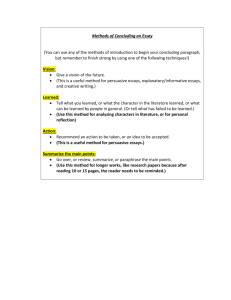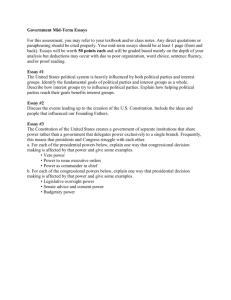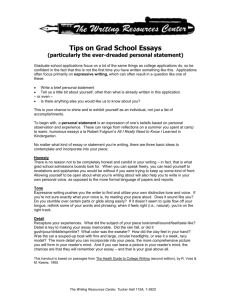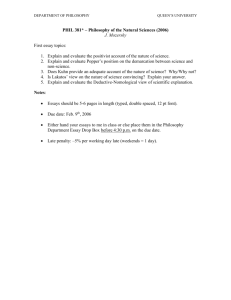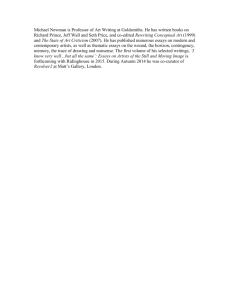4. Grades will be given based upon A=90-100%, B=80
advertisement
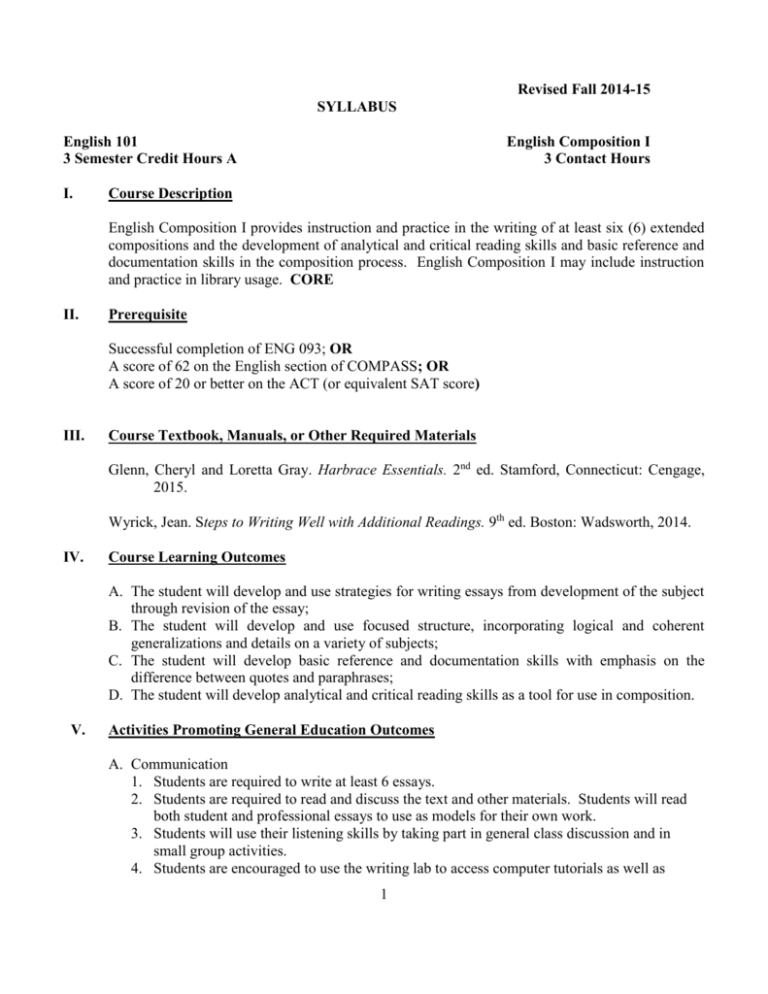
Revised Fall 2014-15 SYLLABUS English 101 3 Semester Credit Hours A I. English Composition I 3 Contact Hours Course Description English Composition I provides instruction and practice in the writing of at least six (6) extended compositions and the development of analytical and critical reading skills and basic reference and documentation skills in the composition process. English Composition I may include instruction and practice in library usage. CORE II. Prerequisite Successful completion of ENG 093; OR A score of 62 on the English section of COMPASS; OR A score of 20 or better on the ACT (or equivalent SAT score) III. Course Textbook, Manuals, or Other Required Materials Glenn, Cheryl and Loretta Gray. Harbrace Essentials. 2nd ed. Stamford, Connecticut: Cengage, 2015. Wyrick, Jean. Steps to Writing Well with Additional Readings. 9th ed. Boston: Wadsworth, 2014. IV. Course Learning Outcomes A. The student will develop and use strategies for writing essays from development of the subject through revision of the essay; B. The student will develop and use focused structure, incorporating logical and coherent generalizations and details on a variety of subjects; C. The student will develop basic reference and documentation skills with emphasis on the difference between quotes and paraphrases; D. The student will develop analytical and critical reading skills as a tool for use in composition. V. Activities Promoting General Education Outcomes A. Communication 1. Students are required to write at least 6 essays. 2. Students are required to read and discuss the text and other materials. Students will read both student and professional essays to use as models for their own work. 3. Students will use their listening skills by taking part in general class discussion and in small group activities. 4. Students are encouraged to use the writing lab to access computer tutorials as well as 1 compose their essays. B. Cognition 1. Students use creative thinking in developing the topic and composing the final impromptu essay. 2. Students use critical thinking skills in supporting the thesis statement with unified and coherent details. C. Information Literacy 1. Students will attend a 1-2 day library orientation to learn how to access library materials to use in research projects. 2. Students will write at least one research paper that requires the use of technological applications. D. Personal Responsibility 1. Students acquire decision-making skills that lead to self-regulation as evidenced by a peerediting assignment. 2. Students acquire a respect for diversity through the interaction they have with one another through these small-group activities as well as through their readings. VI. Outline of Course Topics A. B. C. D. The writing process: prewriting, composing, revising, and editing The product: content, organization, style Writing for various purposes: narration, description, exposition, and persuasion Writing from research VII. Methods of Instruction A. Planning, composing, and revising essays (The National Council of Teachers for English recommends that English 101 be taught with 25 or fewer students per section). Each student must write at least six (6) extended compositions or equivalent assignments. The student must demonstrate writing ability and understanding of different methods of organization, by following a prescribed method of development. At least one essay should come from each of the traditional forms: narration, description, exposition, persuasion, and at least one essay should require library research and APA documentation. These essays should be prepared from acceptable outlines. The essays will be evaluated on the basis of clarity, unity, specificity, adherence to type of organization specified for a particular assignment, and interest; and in these the student must demonstrate at least minimum accepted levels of correctness in grammar, spelling, and sentence structure. B. Revision and correction of essays as returned by the instructor. C. Analysis of errors in sentences and paragraphs abstracted from students' papers and other sources. D. Lecture and discussion on material presented in the text. E. Peer group reviewing/editing. F. Study of vocabulary/dictionary as an aid to composition. G. Use of materials from the Learning Resource Center, both as a class and for individual needs. VIII. Evaluation and Assessment 2 A. Course Grade Assessment 1. Essays a. At least 80% of the final grade must be earned on compositions. b. At least one of these essays will require library research, incorporating the use of technological applications, thus measuring the general education outcome of Information Literacy. c. One of these essays will be the final exam, which will count at least 25% of the final grade. The final will measure the general education outcome of Cognition. 2. Exercises, short tests, examinations, class participation (The remaining 20% of the final grade may be earned from these.) 3. A grade of “C” or better (This grade is required for passing into English 102 or for transfer of credit.) 4. Grades will be given based upon A=90-100%, B=80-89%, C=70-79%, D=60-69%, and F=below 60%. B. Departmental Assessment of General Education Outcomes 1. Students meeting the General Education Outcome of Communication will score an average of 70% or higher on the required essays excluding the research paper and the final essay. 2. Students meeting the General Education Outcome of Cognition will score 70% or higher on the final impromptu essay. This essay will comprise at least 25% of the final grade. 3. Students meeting the General Education Outcome of Information Literacy will score 70% or higher on the research paper which requires the student to incorporate research and scholarship to complete a paper using APA documentation style. 4. Students meeting the General Education outcome of Personal Responsibility will score 70% or higher on the peer-editing assignment which requires the student to use decisionmaking skills that lead to self-regulation. 5. Every five years all ENG 101 instructors will conduct an assessment of the course. The appropriate forms will be completed by each instructor and submitted to the division chair. C. Use of Assessment Findings During the Fall In-service of the year following the scheduled review of ENG 101, a committee will review all course assessment materials submitted by the instructors and division chair. The committee will prepare a report of any recommended curriculum changes for ENG 101 and send the report to the division chair, who will then submit them to the Student Learning Outcomes (SLO) Committee. Upon approval by the SLO Committee, a copy will be filed with the Office of Institutional Planning and Assessment. IX. Attendance Students are expected to attend all classes for which they are registered. Students who are unable to attend class regularly, regardless of the reason or circumstance, should withdraw from that class before poor attendance interferes with the student’s ability to achieve the objectives required in the course. Withdrawal from class can affect eligibility for federal financial aid. X. Statement on Discrimination/Harassment The College and the Alabama State Board of Education are committed to providing both 3 employment and educational environments free of harassment or discrimination related to an individual’s race, color, gender, religion, national origin, age, or disability. Such harassment is a violation of State Board of Education policy. Any practice or behavior that constitutes harassment or discrimination will not be tolerated. XI. Statement of Adherence to ADA Guidelines Instructors will adhere to the Americans With Disabilities Act and/or Section 504 of the Rehabilitation Act (1973) and will publish the following statement on course outlines given to students at the beginning of each semester: “Any individual who qualifies for reasonable accommodations under the Americans With Disabilities Act or Section 504 of the Rehabilitation Act (1973) should notify the instructor immediately.” XII. Plagiarism Policy Plagiarism is the intentional copying of the ideas or words of another and using those ideas or words as one’s own. Instructors may use anti-plagiarism programs to check student work. When outside sources are paraphrased or incorporated verbatim, they must be acknowledged. Students who submit plagiarized or partially plagiarized assignments will not receive credit for those assignments and may be subject to failure in the course. 4




